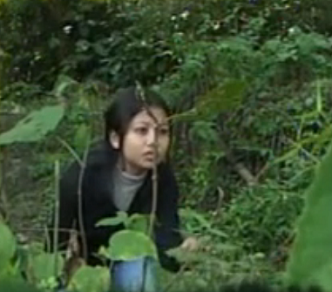Nagaland: Cinema
This page is called ‘Nagaland: Cinema,’ rather than ‘Nagamese cinema’ even though its focus is almost entirely on Nagamese cinema. Its title has been kept as ‘Nagaland: Cinema,’ in order to accommodate films in Naga languages other than Nagamese as well.
The only resources on Nagamese cinema are the excellent Facebook |
Contents |
Nagamese, the language
The people of Nagaland belong to different tribes and speak around 20 languages that can be clubbed into sixteen linguistic groups. That’s right, these are languages, not dialects. Each language is different from the other. Therefore, the Nagas either talk to each other in English—which the majority of Nagas know—or in Nagamese,
A nascent film industry
Unlike Assam, Manipur and even Mizoram, Nagaland does not have a major film industry, partly because it does not have much of an audience for locally made films. One reason for this is that the people of Nagaland are divided into around sixteen linguistic groups—with Nagamese, a modern hybrid language, stepping in as a link language.
Nagamese belongs to no one. For the Nagas Nagamese is a link language, not a language to do any literary work in.An Ao will compose songs in the Ao language. The state’s most popular pop group, the Tetseo Sisters sing in Chokri.
Songs don’t cost a fortune to compose; films do. You can write songs for a small audience. But no Naga language has enough speakers to sustain a film industry.
Therefore, most educated Nagas:
i) do not believe that Nagamese is a language fit for literature or any serious communication, including cinema (but that their own mother tongue and/ or English is).
ii) have never seen a film made in Nagaland. Very few educated Nagas can name an actor or director working in Nagaland’s films.
iii) make fun of the few films that have been made in Nagaland. They say, ‘We only watch Nagamese films to make fun of them.’ When "O Suko Pani Kile Giri Ase" was released in Nov 2008 at Hotel Saramati, Dimapur, some speakers at the premiere urged Nagas to acclaim the efforts put in by the pioneers instead of making fun of them.
iv) feel that the existing crop of films made in Nagaland are ‘insulting the Naga name,’ as Nagaland's main filmmaker Mehara has often been told about his films. Mehara told Morung Express that he has even received threats asking him to stop making films.
Against this background, as Morung Express points out, ‘One man’s dream keeps alive the Nagamese film industry.’ (The Nagaland film industry, actually, because he has made films in other Naga languages, too.) That man is Ajay Kumar Mehara, about whom more later on this page.
Two kinds of films
Two kinds of films are being made in Nagaland.
One the one hand there are full-length feature films, patterned on the commercial Hindi-Urdu films of the 1970s and 1980s. They have songs shot in autumnal forests of the kind popularised by Yash Chopra; the hero comes running into the screen from the left, the heroine from the right and they meet in the middle. The hero lifts up the heroine and does a circle, as the camera circles around them.
The songs, too, are shot like 1970s Hindi-Urdu film songs were.
These films have leading ladies like the glamorous Rose Longchar, and leading men like Neangs and Akash.
Such films are shot in cheerful colours and are melodramatic.
The second stream of films from Nagaland is more gritty and realistic (eg The Debt, Ground Zero). These films cater to more educated audiences, are subtitled in English, are likely to have English titles, deal with Westernised characters and focus more on realistic action than romance.
They are shot in low-light conditions and are influenced by South Korea, the West and 21st century Mumbai films.
However, the second category of films are shorts of 20-24 minutes, and not full-length. These are serious (but not art) films that the Naga elites cannot laugh at.
The films
O Suko Pani Kile Giri Ase
(2008) film director, Akash
Poisa Pora Moram Dangor
Prod: Naga Film Institute
Itu Jiwan
Producer & Director : Anok Pongen
Stars: Rose (Asola), Lipok, Jacob, Atula, T.Siose & Kumar B.K
Khushi Din
(2012)
Director & Producer Anok Pongen
Stars: Zokhoi , Akash Atae Konyak, Hanji, Dilip Kujur and Neangs Conerr
Dukh
An action film.
Producer and hero: Nengba of Dimapur
Mon Tu Jole
A love triangle with Rose Longchar in a vampish negative role, which she excelled in.
Heartbeats
The film’s makers claim that this film was Nagaland's first ever professionally made feature film from NorthEast.
Produced by Nagaland Film Division.
Directed by Nikki Shaan
Journalist
w, d: Akash Atae Konyak;
Produced by Shiyeli
The Debt
Producers: Naga Headhunters
Written and directed by Liyo Kikon
This polished 20 minute feature film is about Christopher, who is kidnapped by an unknown bad man who insists that Christopher owes him a debt. The film is well photographed and has a tight script. Its look and feel is very professional. The film can be seen with subtitles on The Debt/ YouTube.
Ground Zero
Ground Zero/ You Tube with English subtitles Producers: Central Store Group/ Youngster Entertainment
Dir: Imdong Ajem
Script: Impukhtoba [blurred credit title]
24 minutes.
This short feature film is about rival gangs fighting for turf.
The Filmmakers
Ajay Kumar Mehara
One man’s dream keeps alive Nagamese film industry Morung Express
Family
Ajay Kumar Mehara is a filmmaker of north-Indian origin, who lives in Dimapur and passionately identifies with his adoptive state. He is marries to Narola Jamir, an Ao Naga. They have a son and daughter.
Disciplines active in
Mehara is a director, producer, actor and cinematographer.
Education
Under-graduate education: Dimapur Government College (graduated in 1991)
Filmmaking education: The Shankar Mahadevan Institute, Pune
Specialised education in cinematography: Rajiv Film Institute, Guwahati.
Career in cinema
His first Nagamese film: Badla lobo (1996).
His production house: Pooja Film Production, Half Nagarjan, Dimapur.
1996-2012: Number of films produced: 23
The languages in which he has made films: Three in the Poumai, Chang and Yimchunger languages of Nagaland. Non-Naga languages: Assamese, Bengali and Nepali dialects.
Not many others have followed Mehara's example because making films for Nagaland's tiny audience is clearly not profitable. Despite having made around two dozen films, Mehara still does not so much as own a car.
Mehara has also launched of the biggest Nagamese films ever, Fight-Back.

















